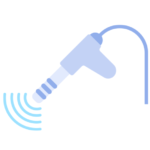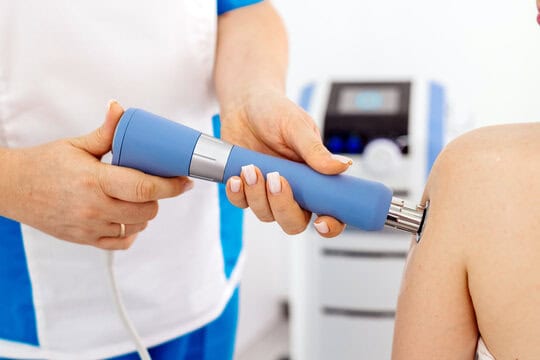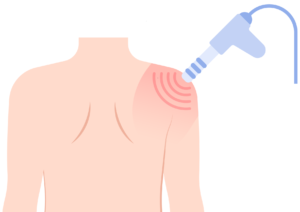


There are two main types of shockwave therapy: focused shockwave therapy and radial
shockwave therapy.
Focused shockwave therapy delivers high-energy acoustic waves to target the deep tissues in
the body. It is used as a treatment for patients with sports injuries, muscle pain, or requiring
back and neck therapy.
Radial shockwave therapy utilizes lower-energy waves that spread out and are ideal for
superficial conditions. It includes chronic pain management, mobility and strength improvement,
and conditions like plantar fasciitis. It is also used in conjunction with focused shockwave
therapy for injuries.
Shockwave therapy is normally considered a safe form of therapy. However, some patients may
experience mild side effects depending on their bodies. Negative side effects can vary from
patient to patient and include:
● Pain or discomfort during or after the treatment. This pain is usually temporary.
● Bruising or swelling in the treated area due to the pressure received.
● Numbness, which is also temporary.
● Skin irritation, which usually resolves within a few days.
Patients should keep in mind that side effects are mild. However, it is advised to consult with an
expert physiotherapist or care provider before starting any treatment, including shockwave
therapy, to determine if it is the most suitable form of treatment for you.
In physiotherapy, shockwave therapy stimulates tissue healing, increases blood flow and reduces inflammation. It is used for chronic pain, musculoskeletal injuries and to help regenerate tissue faster to improve overall recovery outcomes.
Shockwave therapy works incredibly well for treating tendinopathies, plantar fasciitis, and soft tissue injuries. According to physiotherapy studies, pain reduction, mobility boosts and improvements in the patient’s quality of life are achieved after treatment sessions.
Shockwave therapy for ED is typically given to patients in 6–12 sessions that depend on condition severity and individual response. Treatment occurs most often on a weekly or biweekly basis and results in gradual improvement in erectile function and vascular health over time.
Extracorporeal shockwave therapy is an effective, non-invasive solution for nerve regeneration.
The number of shockwave therapy sessions you receive depends on your condition and how
well you respond to the treatment. Therapy for injuries normally takes place over 3 to 5
sessions, carried out 5 to 10 days apart.
Some injuries, like sports injuries, joint and muscle pain, or post-surgical rehabilitation, may
require more sessions. Your physiotherapist will provide a personalized treatment plan based on
your condition.
Shockwave therapy is not illegal. However, in some countries, it may be restricted. This means it
may not be approved, or only licensed physiotherapists can perform the procedure.
Make sure that when you are getting shockwave therapy, it is from a licensed physiotherapist. At
our clinic, we adhere to all local medical regulations, and all of our physiotherapists are
licensed.
The success rate of shockwave therapy is 70–91% for conditions like Achilles tendinopathy, plantar fasciitis and calcific shoulder tendinitis. Physiotherapy treatment using shockwave therapy reduces pain, improves mobility and recovery of function in patients.
Yes, Shockwave therapy is effective for treating erectile dysfunction (ED) of vascular origin by improving blood circulation and tissue repair. Many studies have shown that the use of Cialis leads to improved erectile function and long term improvement, particularly in men with mild ED.
Penile blood flow can be improved by using pelvic floor exercises or aerobic activities or making life style changes. The vascular health is optimized by combining this, with shockwave therapy, weight management, and stress reduction, which also enhances erectile performance.
Typically, shockwave therapy is 30–50 euro per session in physiotherapy, depending on practitioner, location and condition treated.

Shock wave therapy provides significant benefits in physiotherapy, including effective pain relief, enhanced tissue healing, and improved mobility. This non-invasive modality stimulates blood flow and collagen production, facilitating recovery from various musculoskeletal conditions. With minimal side effects and short treatment sessions, it is a valuable option for managing chronic pain effectively.
How Shockwave Therapy Can Effectively Treat Calcific Tendinitis of the Shoulder